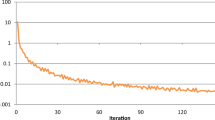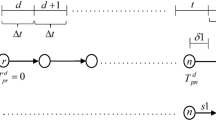Abstract
This work introduces a novel formulation of system optimal dynamic traffic assignment that captures strategic route choice in users under demand uncertainty. We define strategic route choice to be that users choose a path prior to knowing the true travel demand which will be experienced (therefore users consider the full set of possible demand scenarios). The problem is formulated based on previous work by Ziliaskopoulos (Transp Sci 34(1):37–49, 2000). The resulting novel formulation requires substantial enhancement to account for path-based flows and scenario-based stochastic demands. Further, a numerical demonstration is presented on a network with different demand loading profiles. Finally, model complexity, implications on scalability and future research directions are discussed.







Similar content being viewed by others
References
Andreatta G, Romeo L (1988) Stochastic shortest paths with recourse. Networks 18:193–204
Asakura Y, Kashiwadani M (1991) Road network reliability caused by daily fluctuation of traffic flow. In: Proceedings of the 19th PTRC Summer Annual Meeting, Brighton, Seminar G, pp 73–84
Boyles S, Waller ST (2007) A stochastic delay prediction model for real-time incident management. ITE Journal 77:18–24
Cantarella GE, Cascetta E (1995) Dynamic process and equilibrium in transportation networks: toward a unifying theory. Transp Sci 29:305–329
Carey M, Subrahmanian E (2000) An approach to modeling time-varying flows on congested networks. Transp Res 34B(3):157–183
Chriqui C, Robillard P (1975) Common bus line. Transp Sci 9:115–121
Clark SD, Watling DP (2005) Modelling network travel time reliability under stochastic demand. Transp Res B Methodol 39(2):119–140
Daganzo CF (1994) The cell transmission model: a simple dynamic representation of highway traffic consistent with the hydrodynamic theory. Transp Res 28B(4):269–287
Daganzo CF (1995) The cell transmission model, part II: network traffic. Transp Res 29B(2):79–93
Daganzo CF, Sheffi Y (1977) On stochastic models of traffic assignment. Transp Sci 11(3):253–273
Fan Y, Nie Y (2006) Optimal routing for maximizing the travel time reliability. Netw Spat Econ 6(3–4):333–344
Gao S, Chabini I (2006) Optimal routing policy problems in stochastic time dependent networks. Transp Res B Methodol 40(2):93–122
Hamdouch Y, Marcotte P, Nguyen S (2004) A strategic model for dynamic traffic assignment. Netw Spat Econ 4(3):291–315
Horowitz JL (1984) The stability of stochastic equilibrium in a two-link transportation network. Transp Res B 18(1):13–28
Li Y, Ziliakopoulos AK, Waller ST (1999) Linear programming formulations for system optimum dynamic traffic assignment with arrival time based and departure time based demands. Transp Res Rec 1667:52–59
Li Y, Waller ST, Ziliaskopoulos AK (2003) A decomposition scheme for system optimal dynamic traffic assignment models. Netw Spat Econ 3:441–455
Maher MJ, Hughes PC (1997) A probit-based stochastic user equilibrium assignment model. Transp Res B 31(4)
Marcotte P, Nguyen S (1998) Hyperpath formulations of traffic assignment problems. In: Marcotte P, Nguyen S (eds) Equilibrium and advanced transportation modelling. Kluwer Academic Publishers, pp 175–199
Marcotte P, Nguyen S, Schoeb A (2004) A strategic flow model of traffic assignment in static networks. Oper Res 52(2):191–212
Merchant DK, Nemhauser GI (1978a) A model and an algorithm for dynamic traffic assignment problems. Transp Sci 12(3):183–199
Merchant DK, Nemhauser GI (1978b) Optimality conditions for a dynamic traffic assignment model. Transp Sci 12(3):200–207
Miller-Hooks E, Mahmassani HS (2000) Least expected time paths in stochastic, time-varying transportation networks. Transp Sci 34:198–215
Peeta S, Ziliaskopoulos AK (2001) Foundations of dynamic traffic assignment: the past, the present and the future. Netw Spat Econ 1(3–4):233–265
Polychronopoulos GH, Tsitsiklis JN (1996) Stochastic shortest path problems with recourse. Networks 27:133–143
Psaraftis HN, Tsitsiklis JN (1993) Dynamic shortest paths in acyclic networks with Markovian arc costs. Oper Res 41(1):91–101
Sheffi Y, Powell WB (1982) An algorithm for the equilibrium assignment problem with random link times. Networks 12(2):191–207
Unnikrishnan A, Waller ST (2009) User equilibrium with recourse. Netw Spat Econ 9(4):575–593
Waller ST, Ziliaskopoulos AK (2002) On the online shortest path problem with limited arc cost dependencies. Networks 40:216–227
Waller ST, Ziliaskopoulos AK (2006) A chance-constrained based stochastic dynamic traffic assignment model: analysis, formulation and solution algorithms. Transp Res C Emerg Technol 14(6):418–427
Watling DP (1999) Stability of the stochastic assignment problem: a dynamical systems approach. Transp Res B 33:281–312
Watling D, Hazelton ML (2003) The dynamics and equilibria of day-to-day assignment models. Netw Spat Econ 3:349–370
Ziliaskopoulos AK (2000) A linear programming model for the single destination system optimum dynamic traffic assignment problem. Transp Sci 34(1):37–49
Acknowledgments
This research has been made possible by support from the National Science Foundation under CMMI grant #0927315, the 2012 UNSW Gold Star grant, and NICTA. NICTA is funded by the Australian Government as represented by the Department of Broadband, Communications and the Digital Economy and the Australian Research Council through the ICT Centre of Excellence program.
Author information
Authors and Affiliations
Corresponding author
Rights and permissions
About this article
Cite this article
Waller, S.T., Fajardo, D., Duell, M. et al. Linear Programming Formulation for Strategic Dynamic Traffic Assignment. Netw Spat Econ 13, 427–443 (2013). https://doi.org/10.1007/s11067-013-9187-5
Published:
Issue Date:
DOI: https://doi.org/10.1007/s11067-013-9187-5




